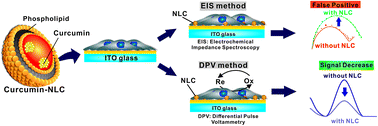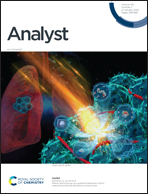A fibronectin-coated gold nanostructure composite for electrochemical detection of effects of curcumin-carrying nanoliposomes on human stomach cancer cells†
Abstract
Curcumin, which is produced by the medicinal herbaceous plant Curcuma longa, has been widely investigated for use as a potential anticancer drug. In this study, the potential toxicity of curcumin-carrying nanoliposomes (curcumin-NLC) toward human stomach cancer cells (MKN-28) was investigated using a new cell-based electrochemical sensing platform. To satisfy both biocompatibility and electroconductivity of the electrodes, the density of the gold nanostructure and the coating conditions of extracellular matrix proteins (fibronectin and collagen) were optimized. The developed platform enabled the successful adhesion and long-term growth of stomach cancer cells on the chip surface, allowing label-free and real-time monitoring of cell viability in a quantitative manner. According to the electrochemical results, both bare curcumin and curcumin-NLC showed toxicity toward MKN-28 cells in the concentration range of 10–100 μM, which was consistent with the results obtained from a conventional colorimetric method (CCK-8). Remarkably, at a low concentration range (<50 μM), this electrochemical platform determined the decrease in cell viability to be approximately 22.8%, 33.9% and 53.1% in the presence of 10, 30, and 50 μM of curcumin-NLC, respectively, compared with the 1.3%, 18.5%, and 28.1% determined by CCK-8, making it 1.7–2 times more sensitive than the conventional colorimetric assay. Hence, it can be concluded that the newly developed fibronectin-coated electroconductive platform is highly promising as an electrochemical detection tool for the sensitive and precise assessment of the anticancer effects of various food-derived compounds with low toxicity.



 Please wait while we load your content...
Please wait while we load your content...